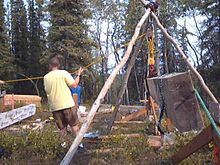| This article needs additional citations for verification. Please help improve this article by adding citations to reliable sources. Unsourced material may be challenged and removed. Find sources: "Lifting equipment" – news · newspapers · books · scholar · JSTOR (November 2023) (Learn how and when to remove this message) |

Lifting equipment, also known as lifting gear, is a general term for any equipment that can be used to lift and lower loads. Types of lifting equipment include heavy machinery such as the patient lift, overhead cranes, forklifts, jacks, building cradles, and passenger lifts, and can also include smaller accessories such as chains, hooks, and rope. Generally, this equipment is used to move material that cannot be moved with manual labor, and are tools used in most work environments, such as warehouses, and is a requirement for most construction projects, such as bridges and buildings. This equipment can also be used to equip a larger number of packages and goods, requiring less persons to move material. Lifting equipment includes any form of equipment that is used for vertical lifting, and equipment used to move material horizontally is not considered lifting equipment, nor is equipment designed to support. As lifting equipment can be dangerous to use, it is a common subject of safety regulations in most countries, and heavy machinery usually requires certified workers to limit workplace injury.
Safety issues
Failure or misuse of heavy machinery can lead to severe or fatal injury, leading regulations to be one of the largest debates in labor laws across the world. Each country sets its own regulations, and enforces different aspects of workplace safety when using lifting equipment.
In the United States
The Occupational Safety and Health Administration sets regulations for all equipment. Contractors are forced to uphold usually strict rules to ensure safety of workers. All machinery is required to be developed by a certified engineer, contractors must follow manufacturer procedures, all users be professionally trained before operating equipment, and equipment must be inspected regularly.
In the United Kingdom
The Health and Safety Executive sets regulations on equipment in the United Kingdom, under the Lifting Operations and Lifting Equipment Regulations. These regulations require equipment be registered on a Statutory Inspection Report Form, is adequate for the task, be subject to routine inspection, and the use of the equipment be properly planned out.
Working load limit
Lifting equipment can be assigned a Working Load Limit (WLL) in the interests of avoiding failure; Working Load Limit is calculated by dividing the Minimum Breaking Load of the equipment by a safety factor. WLL as a concept is not restricted to lifting, being also relevant for mooring ropes. Minimum Breaking Load is also known under the terms of Minimum Breaking Strength or Minimum Breaking Force. WLL of ropes are usually much smaller than their Minimum Breaking Load. WLL is sometimes known as Safe Working Load, but this alternative term is sometimes avoided due to giving the connotation of safety, which may not be guaranteed.
See also
References
- ^ "What is lifting equipment? - Work equipment and machinery". www.hse.gov.uk. Retrieved 2021-09-22.
- "Lifting Equipment". warwick.ac.uk. Retrieved 2021-09-23.
- ^ "1926.1441 - Equipment with a rated hoisting/lifting capacity of 2,000 pounds or less. | Occupational Safety and Health Administration". www.osha.gov. Retrieved 2021-09-22.
- "The Lifting Operations and Lifting Equipment Regulations 1998". Retrieved 22 September 2021.
- Yu, George (December 2021). "Comments on a Case Study on Engineering Failure Analysis of Link Chain". Safety and Health at Work. 12 (4): 544–545. doi:10.1016/j.shaw.2021.05.001. Retrieved 29 December 2024.
- ^ "Report on the investigation of the failure of a mooring line on board the LNG carrier Zarga while alongside the South Hook Liquefied Natural Gas terminal, Milford Haven resulting in serious injury to an officer on 2 March 2015" (PDF). Marine Accident Investigation Branch. June 2017. Retrieved 29 December 2024.
- Glerum, Jay (18 April 2007). Stage Rigging Handbook (3rd ed.). Southern Illinois University Press. p. 38. ISBN 9780809327416. Retrieved 29 December 2024.
This technology-related article is a stub. You can help Misplaced Pages by expanding it. |